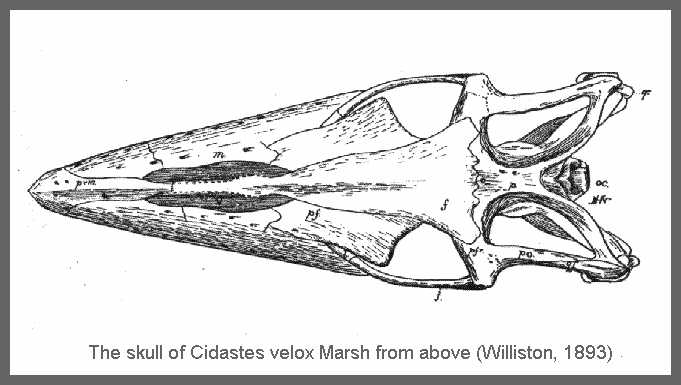
Cope, E. D., 1872.
On Kansas vertebrate fossils.
Amer. Jour. Sci., ser. 3, 3(13):65.
 |
Cope, E. D., 1872. On Kansas vertebrate fossils. Amer. Jour. Sci., ser. 3, 3(13):65. Copyright © 2002-2011 by Mike EverhartePage created 02/03/2002 - Last updated 05/21/2011 |
In which Professor Cope briefly describes a number of new species of marine reptiles and fish found during his visit to western Kansas in 1871.
|
Geology and Natural History.
65 13. On Kansas Vertebrate Fossils. - Prof. E. D. Cope has given a brief account, in the Proceedings of the Philosophical Society of Philadelphia, October, 1871, of some fossil vertebrates in the collections of the State Agricultural College of Kansas. They include the following species: Liodon dyspelor Cope, now for the first time announced as a Kansas species; a species of Liodon near L. proriger Cope, and another near L. ictericus Cope; Liodon latispinus Cope, a new species of large size, nearly equaling the L. Mitchillii, that is 40 or 50 feet long; Clidastes Wymanii ? Marsh; Clidastes cinerarium Cope; Ichthyodectes near I. ctenodon Cope; Anogmius contractus, a new genus and species, near Ichthyodectes in the vertebræ wanting lateral grooves, but like those of Saurocephalus in having the basal elements of the neural and haemal elements not coössified with the centrum; a Saurocephalus near prognathus of Cope. Professor Cope also gives brief notices of some fossils observed by himself on an excursion in the valley of Smoky Hill River, in Kansas. On Butte Creek a large part of the skeleton of a monster saurian, the Liodon dyspelor Cope, was exhumed. On the same bluff another Liodon and a Clidastes were discovered, with some fossil fishes. In neighboring bluffs, bones supposed to be those of a Pterodactyl, of two species of Clidastes, a Dinosaur, a Crocodile and of numerous fishes were brought to light. At a similar location on Fox Creek, M. V. Hartwell found the skeleton of a very large fish, with " uncommonly powerful offensive dentition," probably of the Saurodonts. He names this Cretaceous species Portheus molossus. In the same region the very slender bones of a reptile were obtained, probably of the Testudinates, which he named Protostega gigas. The remains of a large Liodon proriger Cope, were found scattered, "his huge truncate, bowsprit-like snout betraying his individuality at once;" also others of several species of Clidastes. Near Russell Springs, on the Smoky Hill, twenty-six miles distant, a large Clidastes was found, also bones of Liodon ictericus and of two new Clidastes. Prof. Cope adds that the giants of this Cretaceous sea were the Liodon proriger Cope, L. dyspelor Cope, Polycotylus latipinnis, Cope, and Elasmosaurus platyurus Cope. Of these, the first was apparently the most abundant; the second was the longest, exceeding in length perhaps any other known reptile; the last named had the most massive body, and exhibited an extraordinary appearance in consequence of the great length of its neck. AM. JOUR. SCI. --THIRD SERIES, VOL. III, NO. 13. -- JAN., 1872 |